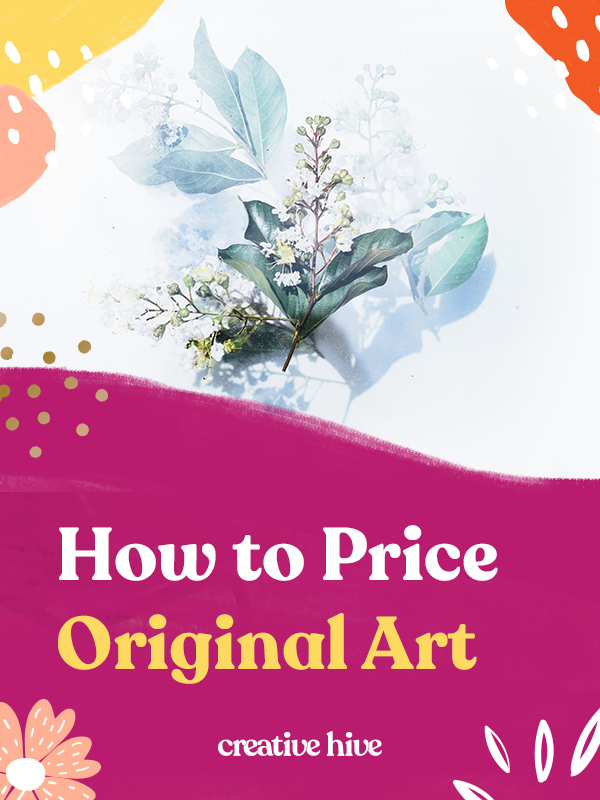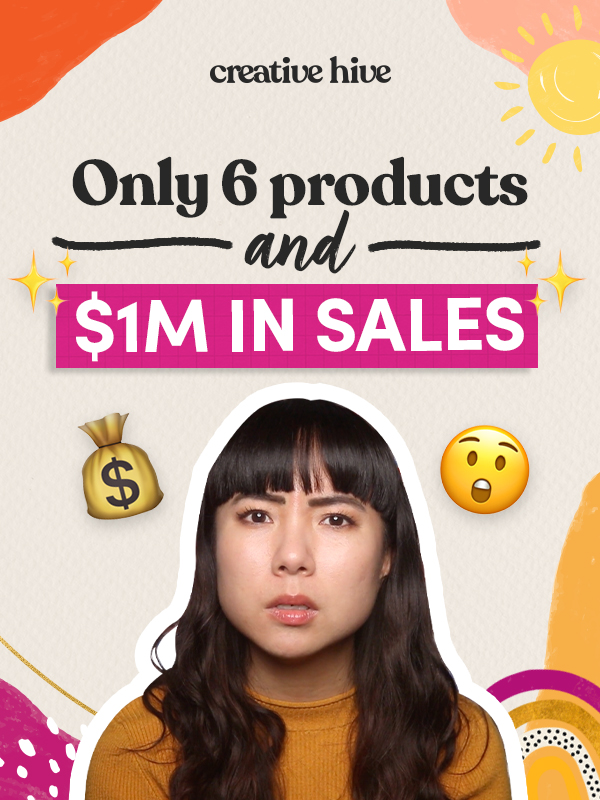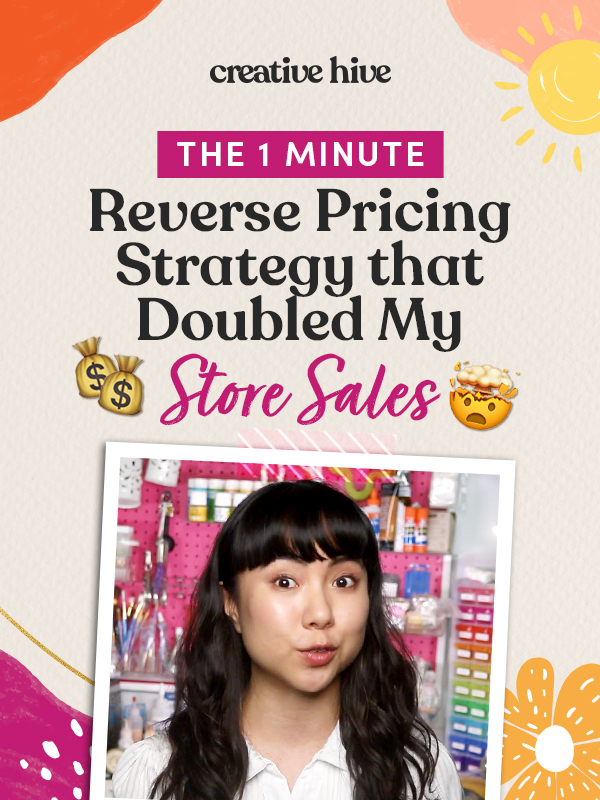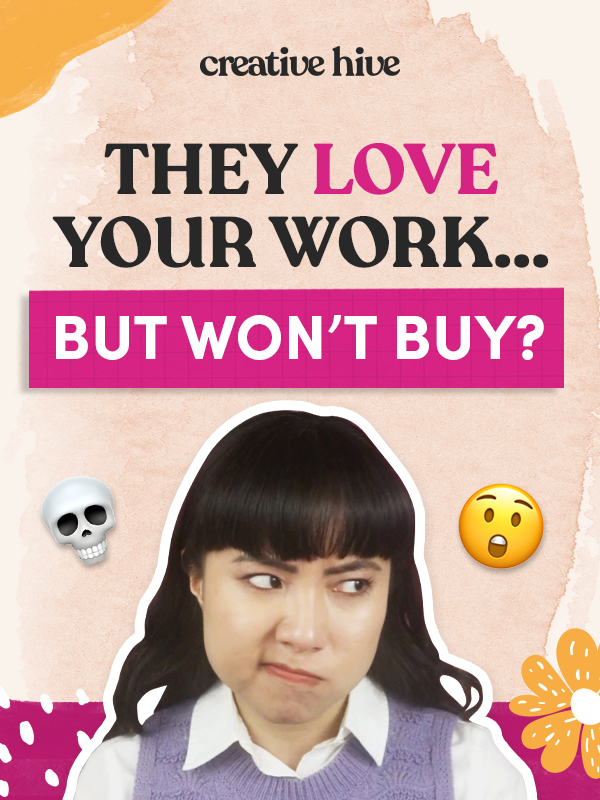I want to help you build a sustainable, profitable handmade business that makes you consistent income and sales. I only ever teach or recommend marketing, social media, pricing, production and branding tips that I’ve personally used successfully in my own 7-figure handmade businesses.
I'm Mei, from Los Angeles!
Read More
Popular Posts You'll Love
Looking for something?
Categories
starting a business
get more traffic
running a business
make more sales
branding
growing a business
mindset & productivity
podcasts
pricing & money
product photography
reviews
selling on etsy
selling on amazon
social media
selling wholesale
- Facebook0
- Twitter3
- Pinterest40
- 43shares
Are you an artist creating original artwork and you’re completely baffled over how to price it? Look no further! I’m giving you a completely customizable formula for how to price your original art.
The Importance of Pricing
I believe that pricing is one of the most important aspects of running your business.
It doesn’t matter how high quality your item is, how interesting, or how much marketing you do.
If you are not charging the right price for your items, your business is going to struggle to be a success.
You should be charging for your item based on the materials and labor that have gone into it, but all of those tips and tricks fly out the window when it comes to something like original artwork.
Why is original artwork different?
Well, because the nature of the art is so different.
People aren’t paying you for the amount of time you spend painting, they’re paying for the finished value it brings to them.
This puts original artwork in a completely different arena than all of the rest of the handmade businesses.
Picasso’s Story
I want to tell a story you’ve probably heard before because it’s a famous one.
One time Picasso was outside doing his drawings and someone asked him to do a little sketch.
So he did a quick sketch in less than five minutes.
When the customer asked how much it would cost and he quoted the cost, the person said, “That’s outrageous. It only took you five minutes to do.”
Picasso replied, “It didn’t take me five minutes. It took me 30 years, and therefore it’s worth it”.
What goes into a piece of art and its value isn’t literally the amount of time that you’ve spent creating it, it’s the years of training.
It’s your eye. It’s so much more.
You want to make sure that you’re charging for those 30 years (or 10 years or whatever it is for you) so that you’re getting a fair price for your original art.
How do you Price your Original Artwork?
The Formula
Let’s start with a formula.
This is just a starting place, then we’ll adjust it based on a number of factors until we get to a final formula you can use for your business.
This will all depend on your:
- experience level
- reputation
- and materials
A standard way of pricing, original art is based on a price per inch. That’s going to vary.
It is nice to have a consistent pricing mechanism across all of your pieces of art, which is why I like to use the price per inch method.
Say that you charge $5 per inch.
You would calculate the total cost by using the square area.
For example, you’d multiply 16 inches x 20 inches by the price per inch.
That would give you a starting number and then you would add onto that any specific materials costs like the frame or the price of the canvas or other items that aren’t already calculated in your formula.
That gives you a starting point.
A huge advantage of using a formula like that is it makes it really simple to calculate prices.
It also makes your pricing consistent across a range of artworks.
This also reflects that people are willing to pay more money for a larger piece of artwork than they are for a smaller piece of artwork.
While this is a great starting point, it won’t capture absolutely everything.
If your jam is creating one inch by one-inch miniature pieces of artwork that are painstaking, then this will not work for you, but this is a really good baseline.
Process
I want you to think about your process.
- What goes into making a piece of art for you?
- How many can you make in a month?
- How many can you expect to sell in a month?
Now, I want you to look at your formula calculation and ask yourself if you can actually make a living with this pricing formula, given how many pieces you’re able to produce?
Some people may be able to look at their formula and realize that they just need to produce a third piece each month and that would work for them.
Other people might have a really complex process where they do a first base and then they need to think about it some more before finishing their piece.
It really does take them a certain amount of time to produce those two pieces a month.
Now you know that you need to alter your per inch formula calculation for your pricing.
Maybe $5 an inch doesn’t work for you, but $6 an inch would.
That’s what I mean by using a base formula, then adjusting it to what works.
Reputation
Another thing you need to consider is your reputation.
When you’re just starting out, you’re not going to be able to command the same prices as someone who’s been established for years and years and has their work in lots of galleries.
I’m not suggesting that you underprice your work.
I do want you to take into consideration your demand on the market, though, and know that you may need to start a little lower and slowly raise your prices.
With that being said, higher-priced items are perceived as more valuable.
If you put up a painting, that’s $5 and you put up a painting, that’s $500, people will assume the $500 painting is better.
This has been shown with wine bottles and how valuable people assume the wine is.
Banksy, the famous street artist has even done this experiment.
He is an artist who commands a lot of money for his pieces, like seven figures for one piece.
He went to a craft fair one time and was trying to sell his pieces of work, which would probably go for a million dollars but at a craft fair he only sold two pieces for around $30!
That just goes to show that the value is relative.
So price your pieces high and people will assume your piece is more worth it.
If you’re able to stand by that price and make the sales that allow you to earn a living wage and a good wage, then you’re in the sweet spot.
Compare Your Work
Another thing that will help inform your personal formula for pricing is comparing your works with other people.
When you see an art piece, you know what size it is, you can actually divide out what that person is charging per inch.
If you go to a site like Etsy, or if you shop around, you can see which pieces are selling.
If you go to galleries, you can see if a piece has been sold or not sold.
When you keep track of this information you can compare your pieces to others that are selling in the market.
Are you a lot more expensive or are you less expensive?
You will want to compare apples to apples here.
Look for paintings that use the same medium as you.
What are other oil paintings going for? What are other pastels going for?
You also want to consider how unique the work is that you’re doing.
If you’re doing landscapes in a very traditional style with oils, you probably want to hang pretty close to your competitors.
However, if you’re doing a very avant-garde style that’s completely out of the box and it’s hard to find competitors, then you can command a slightly higher price.
This is because you don’t have as many competitors in your ballpark.
Time Spent
Another thing to keep in mind is how much business goes into your piece of work.
If you create your work completely from your heart and then just list it for sale all of your time is going into the creation, which is lovely and great!
Other pieces of work, for example, if you do commissions, you may have hours and hours of back and forth with the customer.
That’s time that’s going into your artwork, even if it’s not a part of your painting or your production time.
That needs to be calculated in, as well.
Custom work might encourage you to raise your per inch rate a little bit because of this back and forth time.
Let it Go
My final note on pricing your original art is to let customers go who aren’t willing to pay your worth.
I know this is hard because you want to make the sale.
But you will always run into people who say they think they could paint that or claim that they saw another artist selling it for cheaper.
When that happens, you need to reply, “Okay, that’s great, go with them,” because your work does have a value.
Once you calculate your price and you stick with it, you will find that your customers are attracted to what you do, and they are willing to pay the price for it.
I encourage you to find your personal formula for calculating your artwork prices that will allow continuity over your different pieces of art, and also compensates you fairly for your time and holds you at the right spot in comparison to your competitors.
By using a per inch calculation, you can easily price your original artwork.
By making the adjustments, I’ve suggested, you’ll find this sweet spot where your art is selling, and you’re earning an income that you love!
If you enjoyed this post or have any questions, leave a comment below.
Don’t forget to check out my YouTube channel for more handmade business tips.

Leave a Comment
Liked this article? Share it!
Unlock a Profitable Handmade Business
in Just 12 Weeks Without Using Etsy
or Social Media
FREE WORKSHOP
This workshop is for anyone who makes and sells a handmade or physical product, including jewelry designers, artists, paper designers, bath & body product makers and more!
What You'll Discover
The #1 mistake people make with Etsy & social media that causes shops to FLOP
The secret to making it with your handmade shop so it's no longer just a hobby
How to make sales in your handmade shop with ease so you can finally get to 6-figures
TAKE ME THERE
Leave a Reply Cancel reply
About
Blog
A Sale A Day
Student Login
Free Class
Contact
Terms
Become A Student
Watch On YouTube
Student Reviews
See My Handmade Shop!




Your email address will not be published. Required fields are marked *